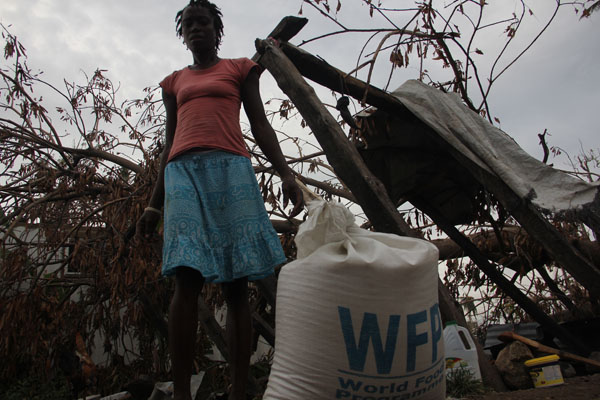Haiti: New Assessment Shows Food Insecurity Halved In The Areas Affected By Hurricane Matthew

However, in the North West, Artibonite, Nippes and La Gonave, although the impact of the hurricane was smaller, its effects coupled with three years of drought and severe flooding have led to a hike in the levels of food insecurity with one million people affected. In total, more than 1.5 million people are food insecure in those six areas following this series of shocks.
The latest Emergency Food Security Assessment (EFSA), conducted in December 2016 by the National Coordination for Food Security (CNSA), the World Food Programme (WFP), the Food and Agriculture Organization of the United Nations (FAO) and FEWS NET, confirms improvements in people’s capacity to feed themselves and their families but at the same time, the need to continue providing assistance in hurricane-affected areas as people rebuild their livelihoods. The assessment also highlights the need to extend assistance beyond these areas in departments where levels of food insecurity have been found to be high.
In the departments of Sud and Grande-Anse, where food assistance was provided from October 2016 onwards, the levels of food insecurity have decreased, respectively, from 79 % after the hurricane to 41 % two months later, and from 78 % to 54 % during the same period. Since the start of the emergency response, under the leadership of the government, WFP has distributed food assistance in those two departments to more than 900,000 people, and fortified foods to more than 20,000 pregnant and nursing women and children under five years old. Meanwhile, FAO has provided seeds, tools, financial resources to more than 21,000 vulnerable households in the departments of Grande-Anse, Sud, Sud-est, West and North West. The levels of food insecurity are highest in the western part of the department of North West (65%), North Artibonite (54%) and in la Gonave island (54%), which were not prioritized regions for emergency response after a first assessment in mid-October.
“The results of the assessment show the very positive impact of our collective efforts in the aftermath of Hurricane Matthew, but also the pressing need to continue and redirect assistance to new areas with higher levels of food insecurity, as well as initiate recovery interventions”, said Ronald Tran Ba Huy, WFP’s Representative in Haiti.
Nathanaël Hishamunda, FAO’s representative in Haiti, echoed this sentiment: “The conclusions of this new assessment reveal that the different interventions contributed to improving the levels of food and nutrition security of those affected by Hurricane Matthew. We now need to consolidate the gains made by working hand in hand with the government, with the goal of reinforcing our interventions in the most vulnerable communities”.
“The government will continue leading these efforts”, said Chrisner Roche, CNSA’s coordinator, “and results of the assessment will ensure our response prioritizes those who are most vulnerable in the new zones highlighted in the assessment”.
The humanitarian community in Haiti urgently needs US$113 million to support food security and agriculture in 2017.
# # #
About CNSA
CNSA is a state entity established in 1996 to guide public policies to sustainably improve the food security of the Haitian people. Specifically, CNSA undertakes the following tasks: defines, directs and harmonizes interventions by actors in the food security sector in Haiti; monitors and evaluates the national food security situation and the results of field programs and projects; disseminates information on the evolution of food security and forms opinions on the subject; translates policies and strategies into operational plans for food and nutrition security.
About WFP
WFP is the world's largest humanitarian agency fighting hunger worldwide, delivering food assistance in emergencies and working with communities to improve nutrition and build resilience. Each year, WFP assists some 80 million people in around 80 countries.
About FAO
FAO leads international efforts to defeat hunger. It helps countries modernize and improve agriculture, forestry and fisheries practices and ensure good nutrition for all. FAO focuses special attention on developing rural areas, home to 70 % of the world's poor and hungry people. Present in Haiti since 1978, FAO supports the government through technical cooperation and agricultural development activities aimed at improving food security and the resilience of households.
For more information please contact:
Harmel Cazeau, CNSA, +509 3414 4347, hcazeau06@gmail.com
Lorene Didier, WFP/Haiti, +509 3800 4976, lorene.didier@wfp.org
Pierre Negaud Duepnor, FAO/Haiti, +509 4420 0726, PierreNegaud.Dupenor@Fao.org
